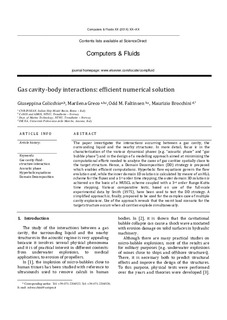| dc.contributor.author | Colicchio, Giuseppina | |
| dc.contributor.author | Greco, Marilena | |
| dc.contributor.author | Faltinsen, Odd Magnus | |
| dc.contributor.author | Brocchini, Maurizio | |
| dc.date.accessioned | 2017-12-07T07:39:22Z | |
| dc.date.available | 2017-12-07T07:39:22Z | |
| dc.date.created | 2015-11-18T09:16:20Z | |
| dc.date.issued | 2015 | |
| dc.identifier.citation | Computers & Fluids. 2015, 113 14-19. | nb_NO |
| dc.identifier.issn | 0045-7930 | |
| dc.identifier.uri | http://hdl.handle.net/11250/2469462 | |
| dc.description.abstract | The paper investigates the interactions occurring between a gas cavity, the surrounding liquid and the nearby structures. In more detail, focus is in the characterization of the various dynamical phases (e.g. “acoustic phase” and “gas bubble phase”) and in the design of a modelling approach aimed at minimizing the computational efforts needed to analyse the cases of gas cavities spatially close to the target structure. Hence, a domain decomposition (DD) strategy is proposed which enables efficient computations. Hyperbolic flow equations govern the flow evolution and, while the inner domain 1D solution is calculated by means of an HLL scheme for the fluxes and a 1st order time stepping, the outer domain 3D solution is achieved on the basis of a MUSCL scheme coupled with a 3rd order Runge–Kutta time stepping. Various comparative tests, based on use of the full-scale experimental data by Smith (1975), have been used to test the DD strategy. A simplified approach is, finally, proposed to be used for the complex case of multiple cavity explosions. Use of the approach reveals that the worst load scenario for the target structure occurs when all cavities explode simultaneously. | nb_NO |
| dc.language.iso | eng | nb_NO |
| dc.publisher | Elsevier | nb_NO |
| dc.rights | Attribution-NonCommercial-NoDerivatives 4.0 Internasjonal | * |
| dc.rights.uri | http://creativecommons.org/licenses/by-nc-nd/4.0/deed.no | * |
| dc.title | Gas cavity-body interactions: Efficient numerical solution | nb_NO |
| dc.type | Journal article | nb_NO |
| dc.type | Peer reviewed | nb_NO |
| dc.description.version | acceptedVersion | nb_NO |
| dc.source.pagenumber | 14-19 | nb_NO |
| dc.source.volume | 113 | nb_NO |
| dc.source.journal | Computers & Fluids | nb_NO |
| dc.identifier.doi | 10.1016/j.compfluid.2014.11.002 | |
| dc.identifier.cristin | 1290225 | |
| dc.relation.project | Norges forskningsråd: 223254 | nb_NO |
| dc.description.localcode | © 2014. This is the authors’ accepted and refereed manuscript to the article. This manuscript version is made available under the CC-BY-NC-ND 4.0 license http://creativecommons.org/licenses/by-nc-nd/4.0/ | nb_NO |
| cristin.unitcode | 194,64,20,0 | |
| cristin.unitname | Institutt for marin teknikk | |
| cristin.ispublished | true | |
| cristin.fulltext | postprint | |
| cristin.qualitycode | 1 | |

